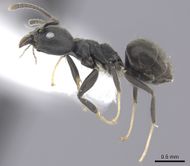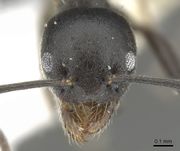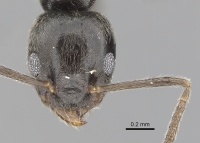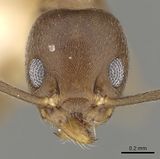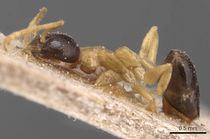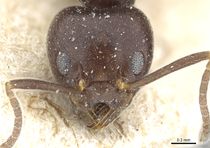Key to Oriental Technomyrmex
This worker key is based on: Bolton, B. 2007b. Taxonomy of the dolichoderine ant genus Technomyrmex Mayr (Hymenoptera: Formicidae) based on the worker caste. Contributions of the American Entomological Institute. 35(1):1-149.
NOTE. The locations and relative lengths of various setae are critical in the determination of many species. Abraded, or old and damaged, specimens may be difficult or impossible to identify correctly.
You may also be interested in
1
- With head in profile the dorsal surface of the frontal carina, or the dorsum immediately mesad of the frontal carina, with setae present; at least with one seta present somewhere along the length of the frontal carina, or more usually with a row of 2 - 4 . . . . . 2
- With head in profile the dorsal surface of the frontal carina and the dorsum immediately mesad ofthe frontal carina, entirely without setae . . . . . 31
2
return to couplet #1
- Either dorsal (outer) surfaces of middle and hind tibiae, or antennal scapes, or both with suberect to erect projecting setae present. . . . . . 3
- Both dorsal (outer) surfaces of middle and hind tibiae and antennal scapes without suberect to erect projecting setae . . . . . 7
3
return to couplet #2
- Maxillary palp with 5 segments, labial palp with 3 segments. Anterior clypeal margin with a long, narrow median incision, the length of the incision at least equal to its maximum width or longer than its maximum width; inner margin of incision meets anterior clypeal margin in a sharp angle on each side. (India, China, Vietnam, Thailand, Malaysia (West Malaysia, Sarawak, Sabah), Indonesia (Sumatra, Java, Batjan, Sulawesi)) . . . . . Technomyrmex pratensis (in part - also #17)
- Maxillary palp with 6 segments, labial palp with 4 segments. Anterior clypeal margin almost transverse or at most with a very shallow, weak median impression or feeble concavity that is much broader than long; if a weak concavity present it curves evenly into the more lateral portion of the anterior clypeal margin . . . . . 4
4
return to couplet #3
- With head in full-face view the dorsum glassy smooth and shining, unsculptured except for small pits from which setae arise. Scape shorter, SI 81 - 89. Promesonotum relatively short and stout, DTI < 125 . . . . . 5
- With head in full-face view the dorsum covered with fine sculpture. Scape longer, SI 123 - 140. Promesonotum relatively long and narrow, DTI > 130 . . . . . 6
5
return to couplet #4
- Dorsal surface of mandible with a longitudinal groove near its outer margin, the groove flanked by a cuticular rim on each side; groove extends from base almost the entire length of the mandible. Eyes located more posteriorly, EPI 96 – 1000. (Malaysia (West Malaysia, Sabah)) . . . . . Technomyrmex mandibularis
- Dorsal surface of mandible without a longitudinal groove anywhere. Eyes located more anteriorly, EPI ca 72. (Indonesia (Sumatra)) . . . . . Technomyrmex convexifrons
6
return to couplet #4
- Longest setae on first gastral tergite longer than maximum diameter of eye. Eye located at or slightly behind midlength of head, EPI 100 - 120. Setae abundant everywhere, very dense, long and luxuriant on all body surfaces. Propodeum in profile with a long, shallowly convex dorsum. Larger species, HL 0.85 - 1.05. (Malaysia (West Malaysia), Indonesia (Kalimantan, Sumatra, Sulawesi), Philippines (Leyte, Mindanao, Negros, Bohol)) . . . . . Technomyrmex grandis
- Longest setae on first tergite shorter than maximum diameter of eye. Eye located slightly in front of midlength of head, EPI 80 - 86. Setae present on all dorsal surfaces but short and sparse everywhere. Propodeum in profile with a short, humped dorsum. Smaller species, HL 0.70 - 0.79. (Malaysia (West Malaysia, Sarawak, Sabah), Brunei, Philippines (Luzon, Leyte, Romblon)) . . . . . Technomyrmex wheeleri
7
return to couplet #2
- With head in full-face view the dorsum glassy smooth and shining, unsculptured except for small pits from which setae arise . . . . . 8
- With head in full-face view the dorsum covered with fine sculpture, usually either reticulate-shagreenate or microreticulate everywhere; sometimes this sculpture reduced and superficial but surface never glassy smooth . . . . . 9
8
return to couplet #7
- Anterior clypeal margin with a distinct near-semicircular median impression. Dorsum of mesonotum mostly smooth, with only faint traces of superficial sculpture; propodeal dorsum slightly more strongly sculptured than mesonotum. Eye slightly larger, OI 24 - 27. (Malaysia (Sabah)) . . . . . Technomyrmex tatius
- Anterior clypeal margin transverse or nearly so, at most with an extremely weak median indentation, without a near-semicircular impression. Dorsum of mesonotum very densely finely reticulate-punctate; propodeal dorsum as densely sculptured as mesonotum: Eye slightly smaller, or 20 - 24. (Malaysia (West Malaysia, Sarawak), Brunei, Singapore) . . . . . Technomyrmex strenuus
9
return to couplet #7
- With head in profile the dorsum behind the level of the posterior margin of the eye entirely lacks setae (i.e. setae on the dorsum of the head are restricted to the frontal carinae) . . . . . 10
- With head in profile the dorsum behind the level of the posterior margin of the eye with one or more pairs of setae present (i.e. setae on the dorsum of the head are not restricted to the frontal carinae) . . . . . 16
10
return to couplet #9
- Entire petiole not the same colour as the gaster; at least the anterior three-quarters of the petiole is yellow and much lighter than the dark brown to black gaster . . . . . 11
- Entire petiole the same colour (or very nearly) as the gaster, uniformly brown or black. . . . . . 12
11
return to couplet #10
- Tibiae of all legs yellow, contrasting strongly with the brown femora. Propodeum marked With yellow at least dorsally, sometimes entirely yellow. Scape somewhat longer, SI 120 - 121. (Indonesia (Sulawesi)) . . . . . Technomyrmex pluto
- Tibiae of all legs dark brown, the same colour as the femora. Propodeum entirely dark brown to black, without yellow markings. Scape somewhat shorter, SI 112 - 115. (Indonesia (Sulawesi)) . . . . . Technomyrmex hades
12
return to couplet #10
- Basal half of mandible with a longitudinal groove dorsally, close to its outer margin; the groove extends about half the length of the mandible and is bounded laterally by sharp longitudinal edges. In full-face view the eyes are located distinctly more posteriorly on the head, at or slightly behind the midlength, EPI > 110. (Sri Lanka, India, Vietnam, China, Taiwan, North Korea, Japan, Brunei) . . . . . Technomyrmex brunneus
- Basal half of mandible evenly transversely convex dorsally, without a longitudinal groove anywhere. In full-face view the eyes are located distinctly more anteriorly on the head, in front of the midlength, EPI 55 - 92 . . . . . 13
13
return to couplet #12
- In full-face view the posterior margin of the head is broadly emarginate across its width. Anterior clypeal margin with a small but sharply defined semicircular median notch. Head broader, CI 95 - 106. (India, Nepal, Vietnam, Thailand, Malaysia (West Malaysia, Sabah, Sarawak), Singapore, Brunei, Indonesia (Kalimantan), Philippines (Luzon)) . . . . . Technomyrmex elatior
- In full-face view the posterior margin of the head has a small, shallow median indentation only. Anterior clypeal margin with at most a weak and very shallow median concavity. Head narrower, CI 85 - 95 . . . . . 14
14
return to couplet #13
- Propodeum in profile with dorsum convex and curving broadly into the declivity. Setae on first gastral tergite distinctly longer than maximum diameter of eye, Pronotum, mesonotum and propodeum all Inflated and with a swollen appearance. Pronotum broader, PW 0.45 – 0.48. Scape relatively longer, SI 114 – 124. (Malaysia (West Malaysia, Sarawak, Sabah), Indonesia (Sumatra, Sulawesi)) . . . . . Technomyrmex butteli
- Propodeum in profile with dorsum flat or nearly flat and meeting the declivity in a blunt or sharply defined angle. Setae on first gastral tergite usually shorter than maximum diameter of eye, at most about equal to maximum diameter of eye. Pronotum, mesonotum and propodeum not inflated, without a swollen appearance. Pronotum narrower, PW 0.35 – 0.44. Scape relatively shorter, SI 91 – 115 . . . . . 15
15
return to couplet #14
- Scape relatively short and promesonotum relatively short and broad, SI 91 - 102, DTI 1 10- 124. Eye somewhat smaller, OI 24 - 27. With mesosoma in absolute profile the mesonoral dorsal outline convex, more or less evenly rounded. In same view the junction of the propodeal dorsum and declivity is blunt. (Tramp species: Sri Lanka, India, Vietnam, Malaysia (West Malaysia, Sabah, Sarawak), Singapore. Indonesia (Java, Bali, Lombok, Ambon, Sulawesi, Seram, Irian Jaya). Philippines (Mindoro, Luzon), Papua New Guinea, Solomon Is, Palau Is, Micronesia. Hawaii) . . . . . Technomyrmex albipes
- Scape relatively long and promesonotum relatively long and narrow, SI 104 - 115, DTI 128 - 141. Eye somewhat larger, OI 29 - 32. With mesosoma in absolute profile the mesonotal dorsal outline with a more or less flat anterior section that passes through an obtuse angle to a distinctly more strongly sloped posterior declivity. In same view the junction of the propodeal dorsum and declivity is sharply angular. (Tramp species: India, Bangladesh, Myanmar, Thailand, Malaysia (West Malaysia), Indonesia (Sulawesi), Philippines (Palawan). Niue I., Vanuata, Samoa, Fiji Is, French Polynesia, Hawaii, Christmas I.) . . . . . Technomyrmex vitiensis
16
return to couplet #9
- Anterior clypeal margin with a sharply defined deep and very conspicuous median notch or incision that is semicircular to deeply U-shaped . . . . . 17
- Anterior clypeal margin at most with a poorly defined feeble median indentation or very shallow median concavity . . . . . 19
17
return to couplet #16
- Maxillary palp with 5 segments, labial palp with 3 segments. With head in profile a long dorsal seta present at level of both anterior and posterior margins of eye. Setae on first gastral tergite distinctly much longer than maximum diameter of eye. Dorsum of head with weak superficial sculpture only, not blanketed with dense reticulate-shagreenate sculpture. (India, China, Vietnam, Thailand, Malaysia (West Malaysia, Sarawak, Sabah), Indonesia (Sumatra, Java, Sulawesi, Batjan)) . . . . . Technomyrmex pratensis
(in part - also #3)
- Maxillary palp with 6 segments, labial palp with 4 segments. With head in profile a long dorsal seta present at level of anterior margin of eye but without one at level of posterior margin of eye. Setae on first gastral tergite at most equal to maximum diameter of eye. Dorsum of head blanketed with dense reticulate-shagreenate sculpture . . . . . 18
18
return to couplet #17
- Dorsum of head in profile with setae present at the posterior margin. Inner margin of clypeal notch meets the anterior clypeal margin in a sharp angle on each side. Setae on gastral tergites 1 - 2 sparse and minute, the longest less then 0.50 x the maximum diameter of the eye. Setae on gastral tergite 4 about twice as long as those on gastral tergites 1 – 2. (Thailand, Vietnam) . . . . . Technomyrmex yamanei
- Dorsum of head in profile without setae at the posterior margin. Inner margin of clypeal notch curves bluntly into the anterior clypeal margin on each side. Setae on gastral tergites 1 - 2 numerous and conspicuous, the longest about equal to the maximum diameter of the eye or only functionally shorter. Setae on gastral tergite 4 not twice as long as those on gastral tergites 1 - 2. (Laos, Thailand, Malaysia (West Malaysia, Sarawak), Indonesia (Sumatra, Java, Sulawesi)) . . . . . Technomyrmex modiglianii
19
return to couplet #16
- With head in profile the dorsum without a pair of setae at, or extremely close to, the level of the posterior margin of the eye. Dorsum of head behind the level of the posterior margin of the eye usually with one, more rarely with two, pairs of setae . . . . . 20
- With head in profile the dorsum with a pair of setae at, or extremely close to, the level of the posterior margin of the eye. Dorsum of head behind the level of the posterior margin of the eye with one or more pairs of setae present . . . . . 26
20
return to couplet #19
- With head in profile the dorsum behind the level of the posterior margin of the eye with two pairs of inconspicuous short setae. (Tramp species: not yet recorded from these regions) . . . . . Technomyrmex pallipes
- With head in profile the dorsum behind the level of the posterior margin of the eye conspicuously with only a single pair of setae . . . . . 21
21
return to couplet #20
- With propodeum in absolute profile the dorsum meets the declivity in a markied angle . . . . . 22
- With propodeum in absolute profile the dorsum meets the declivity through a rounded curve . . . . . 24
22
return to couplet #21
- Eyes located relatively posteriorly on the head, EPI 100 or more. Basal two-thirds or more of hind basitarsus black, the same colour as the hind tibia. (Malaysia (West Malaysia, Sarawak), Indonesia (Java)) . . . . . Technomyrmex rotundiceps
- Eyes located relatively anteriorly on the head EPI < 90. Entire hind basitarsus distinctly paler than the hind tibia . . . . . 23
23
return to couplet #22
- Setae on first gastral tergite very long, about 1.50 x longer than the maximum diameter of the eye. Scape shorter, SI 88. Eve smaller) OI 21. Mesosoma relatively short and stocky, DTI 112 - 119. (Malaysia (West Malaysi)) . . . . . Technomyrmex myops
- Setae on first gastral tergite short, the longest about equal to the maximum diameter of the eye. Scape longer, SI 95 - 107. Eye larger, OI 25 - 30. Mesosoma relatively more elongate. DTI 127 - 135. (Tramp species: Vietnam, Thailand, Singapore, Malaysia (West Malaysia, Sabah), Indonesia (Flores, Krakatau Is), Philippines (Luzon. Bayagnan), Papua New Guinea, Marianas Is, Micronesia) . . . . . Technomyrmex difficilis
24
return to couplet #21
- Pronotum, mesonotum and propodeal declivity without setae. Posteriormost setae on dorsum of head and longest setae on first gastral tergite very short, only about 0.35 x the maximum diameter of the eye. (Papua New Guinea) . . . . . Technomyrmex tonsuratus
- Pronotum, mesonotum and propodeal declivity with setae present. Posteriormost setae on dorsum of head and longest setae on first gastral tergite much longer, > 0.60 x the maximum diameter of the eye . . . . . 25
25
return to couplet #24
- Middle and hind coxae dark brown to black, the same colour as the mesosoma or very nearly so. Dorsume of head with coarse microreticulate-punctulate sculpture. Larger species, HW 0.71 - 0.73; scape relatively slightly shorter, eyes smaller and located somewhat more posteriorly, SI 108 - 117, OI 24 - 25, EPI 85 - 90. (Papua New Guinea) . . . . . Technomyrmex mixtus
- Middle and hind coxae yellow, strongly contrasting with the blackish brown mesosoma. Dorsum of head with fine superficial microreticulate sculpture only. Smaller species, HW 0.56 - 0.58; scape relatively slightly longer, eyes larger and located somewhat more anteriorly SI 117 - 121, OI 27 - 29, EPI 77 - 81. (Indonesia (Irian Jaya), Papua New Guinea) . . . . . Technomyrmex albicoxis
26
return to couplet #19
- Posterior margin of head with a transverse row of 6 - 10 setae across its width, 3 – 5 on each side of the midline . . . . . 27
- Posterior margin of head without a transverse row of setae across its width (margin may be crossed by 2 setae but these arise well in front of the margin) . . . . . 29
27
return to couplet #26
- Head, mesosoma, petiole, gaster and middle and hind coxae uniformly black. Small species with small eyes; HW 0.51, OI 23. (Brunei) . . . . . Technomyrmex certus
- Head, mesosoma, petiole, gaster and middle and hind coxae not uniformly black. Larger species with larger eyes; HW 0.62 - 0.64, OI 26 - 28 . . . . . 28
28
return to couplet #27
- Petiole and middle and hind coxae yellow, lighter in colour than the mesosoma. Longest hairs on first gastral tergite shorter than the maximum diameter of the eye. (India) . . . . . Technomyrmex indicus
- Petiole and middle and hind coxae light brown, the same colour as the mesosoma. Longest hairs on first gastral tergite longer than the maximum diameter of the eye. (Indonesia (Irian Jaya)) . . . . . Technomyrmex prevaricus
29
return to couplet #26
- Longest setae on first gastral tergite short and stubbly, only about 0.50 x the maximum diameter of the eye. Pair of setae on the dorsum of the head closest to posterior margin very short, only about 0.45 x maximum diameter of eve. With head in full-face view the eyes strongly convex, their outer margins conspicuously break the outlines of the sides. (Malaysia (Sabah)) . . . . . Technomyrmex fornax
- Longest setae on first gastral tergite at least equal to the maximum diameter of the eye. Pair of setae on the dorsum of the head closest to posterior margin longer, at least 0.70 x maximum diameter of eye or usually more. With head in full-face view the eyes more weakly convex, their outer margins at most just touch the outlines of the sides . . . . . 30
30
return to couplet #29
- In profile the propodeal dorsum and declivity meet in a distinct sharp angle. Eyes located at mid length of head in full-face view, EPI 98; eye relatively larger, OI 30. Frontal carinae each with 2 setae present; mesonotum with 1 pair of setae. Larger species with narrower head, HW 0.71, SL 0.84, CI 87. (Malaysia (Sabah)) . . . . . Technomyrmex subgracilis
- In profile the propodeal dorsum and declivity meet in a bluntly rounded angle or curve. Eyes located in front of midlength of head in full-face view, EPI 78 - 85; eye relatively smaller, OI 25 - 27. Frontal carinae each with 3 – 4 setae present; mesonotum with 2 - 3 pairs of setae. Smaller species with broader head, HW 0.56 - 0.62, SL 0.56 - 0.72, CI 92 - 95. (Indonesia (Irian Jaya), Papua New Guinea; also in Australia (Queensland)) . . . . . Technomyrmex cheesmanae
31
return to couplet #1
- Second gastral tergite without setae . . . . . 32
- Second gastral tergite with at least one pair of setae . . . . . 37
32
return to couplet #31
- Third gastral tergite with a transverse row of 6 - 8 setae present. Anterior clypeal margin in full-face view with a conspicuous long, U-shaped median incision. Strongly polymorphic species. (Malaysia (West Malaysia. Sarawak, Sabah), Brunel, Indonesia (Kalimantan, Sumatra)) . . . . . Technomyrmex lisae
- Third gastral tergite without setae. Anterior clypeal margin in full-face view at most with a small, shallow median impression or a weak indentation of the margin . . . . . 33
33
return to couplet #32
- Leading edges of scapes and lateral margins of head in full-face view with dense, conspicuously elevated short pubescence. Metathoracic spiracles borne on strongly projecting tubercles. Polymorphic species. (Malaysia (Sabah)) . . . . . Technomyrmex horrens
- Leading edges of scapes and lateral margins of head in full-face view with minute appressed pubescence only. Metathoracic spiracles not borne on strongly projecting tubercles. Monomorphic species . . . . . 34
34
return to couplet #33
- Scape longer, SI 120 – 126. Eyes located more posteriorly, EPI 60 – 70. (Papua New Guinea) . . . . . Technomyrmex gilvus
- Scape shorter, SI 85 - 100. Eyes located more anteriorly, EPI 44 - 58 . . . . . 35
35
return to couplet #34
- Eye relatively small, OI 23 - 25. In full-face view the outer margin of the eye far inset from the outline of the side of the head, the distance separating them almost equal to the basal width of the scape. (Malaysia (Sabah), Indonesia (Sulawesi), Papua New Guinea) . . . . . Technomyrmex dubius
- Eye relatively large, OI 27 - 30. In full-face view the outer margin of the eye close to or even interrupting the outline of the side of the head, at maximum the distance separating them only a fraction of the basal width of the scape . . . . . 36
36
return to couplet #35
- With mesosoma in profile the outline of the mesonotal dorsum with a long, more or less flat anterior section; the dorsum then passes through a distinct angle or step into a much more steeply descending. declivitous posterior face. Scape averaging slightly longer, SI 93 - 100. (Malaysia (West Malaysia), Indonesia (Java), Philippines (Palawan)) . . . . . Technomyrmex textor
- With mesosoma in profile the outline of the mesonotal dorsum consists of a single convex surface, not divided into a flat anterior section and a posterior declivity that are separated by a step or angle. Scape averaging slightly shorter, SI 85 - 93. (Japan, North Korea) . . . . . Technomyrmex gibbosus
37
return to couplet #31
- Maxillary palp with 4 segments, labial palp with 3 segments. Setae on gastral tergites 2 - 3 extremely short and inconspicuous, only about 0.20 x the maximum diameter of the eye
. . . . . Technomyrmex reductus
- Maxillary palp with 6 segments, labial palp with 4 segments. Setae on gastral tergites 2 - 3 conspicuous, at least 0.50 x the maximum diameter of the eye . . . . . 38
38
return to couplet #37
- With propodeum in absolute profile the dorsal surface with a conspicuous abrupt indentation or notch in its outline, close to or at its mid length; in dorsal view this indentation appears as a transverse groove . . . . . 39
- With propodeum in absolute profile the dorsal surface without an indentation or notch in its outline; in dorsal view without a transverse groove . . . . . 40
39
return to couplet #38
- Head, mesosoma and gaster dark brown to black; dorsal surfaces of head and pronotum matt and dull, blanketed with dense reticulate-punctulate sculpture everywhere. Mesopleuron entirely reticulate-punctulate. Middle and hind tarsi yellow, much lighter than the dark brown to black tibiae, the two strongly contrasting. (Malaysia (Sabah)) . . . . . Technomyrmex impressus
- Head, mesosoma and gaster light brown; dorsal surfaces of head and pronotum superficially sculptured. Mesopleuron smooth, or at most with faint superficial reticulation. Middle and hind tarsi dull yellow, approximately the same colour as the tibiae, the two not strongly contrasting. (Malaysia (Sarawak)) . . . . . Technomyrmex gaudens
40
return to couplet #38
- Head capsule and gaster very dark brown, almost black, very strongly contrasting to the mandibles, antennae, mesosoma, petiole and legs which are all the same shade of yellow. (Sri Lanka) . . . . . Technomyrmex bicolor
- Head capsule and mesosoma unicolourous or nearly so; colours variable but head and body not strikingly bicoloured as described above . . . . . 41
41
return to couplet #40
- In profile the full adult colour of the head, mesosoma and gaster brown to black, all three the same shade or very nearly so . . . . . 42
- In profile either the full adult colour of the head, mesosoma and gaster all yellow to light yellowish brown, or the head or gaster, or often both, slightly darker in shade than the mesosoma. (Sri Lanka, China (Hong Kong), Taiwan, Thailand, Malaysia (West Malaysia, Sabah), Brunei, Singapore, Indonesia (Krakatau Is) . . . . . Technomyrmex horni
and Technomyrmex schimmeri
42
return to couplet #41
- Propodeum in profile with a relatively long, flat dorsal surface: length of dorsum almost twice the depth of the declivity to the spiracle, or more. (Myanmar, Thailand, Vietnam, Nepal, China) . . . . . Technomyrmex obscurior
- Propodeum in profile with a relatively short, convex to almost flat dorsal surface: length of dorsum at most is equal to the depth of the declivity to the spiracle, often less . . . . . 43
43
return to couplet #42
- Scape relatively very long, SI 130 - 135. (China (Guilin)) . . . . . Technomyrmex antennus
- Scape relatively shorter, SI 88 - 125 . . . . . 44
44
return to couplet #43
- Middle and hind tibiae yellow, the same colour as the tarsi. Median clypeal notch broad and shallow, less than semicircular; in full-face view the maximum depth of the notch only about 0.25 x the distance from the posterior margin of the notch to the clypeal suture. Second and third gastral tergites each apparently with one pair of long setae. (India) . . . . . Technomyrmex rector
- Middle and hind tibiae brown to blackish brown, darker than the off-white to dull yellow tarsi. Median clypeal notch longer; in full-face view the maximum length of the notch about 0.45 x the distance from the posterior margin of the notch to the clypeal suture, or more. Second gastral tergite with 2 pairs of long setae; third gastral tergite with 3 pairs . . . . . 45
45
return to couplet #44
- Middle and hind coxae off-white to yellow, distinctly much lighter in colour than the femora and the mesosoma and strongly contrasting with them. (Thailand, Malaysia (West Malaysia, Sarawak, Sabah), Singapore, Brunei, Indonesia (Java, Sulawesi), Palau Is, Micronesia) . . . . . Technomyrmex kraepelini
- Middle and hind coxae light to dark brown, about the same colour as the femora and mesosoma, not strongly contrasting. (Malaysia (Sarawak), Indonesia (Sumatra), Philippines (Luzon, Romblon)) . . . . . Technomyrmex sundaicus





























